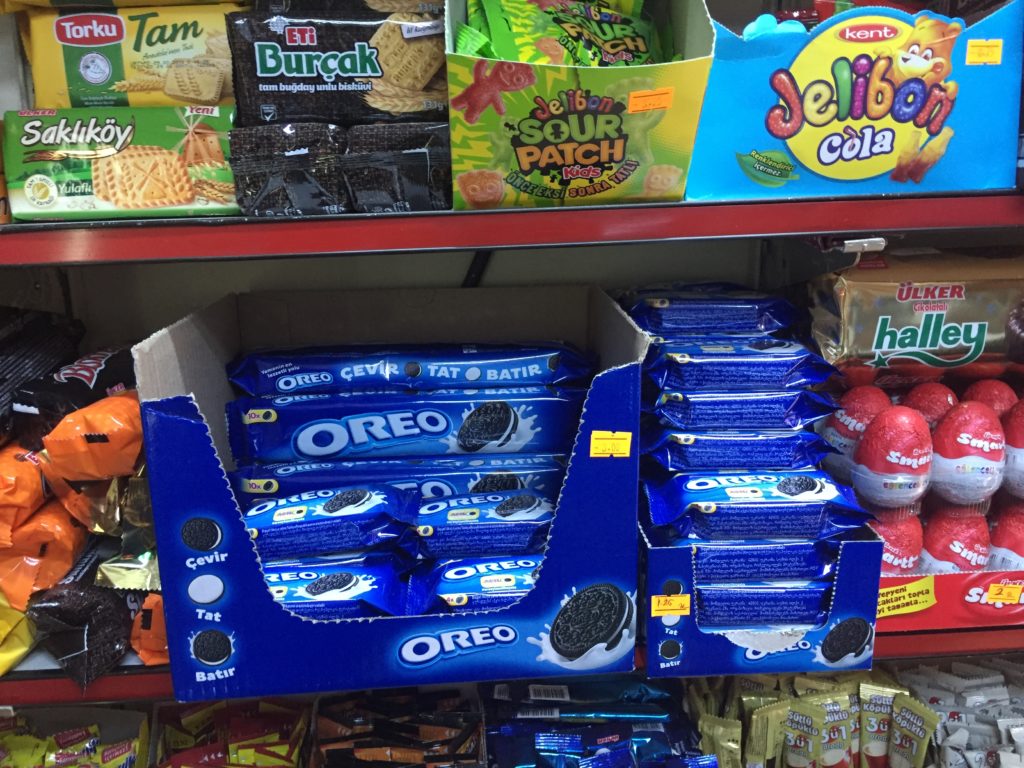What do you need for successful shopper marketing? Great insight? For sure. A great retail selling story to get support from your customers? Indeed! Really simple execution at the point of purchase? Absolutely. Here is a simple case of a really simple in-store execution which had all these things, but still failed. Why? Because shopper marketing doesn’t work in isolation. In this post I’m going to share a simple case and demonstrate that winning at the point of purchase isn’t enough and that shopper marketing works best when integrated as part of a five-step Total Marketing approach. I’m going to use a single store as an example, and in no way am I criticizing this particular campaign (I simply don’t know enough about it). I’m merely using this to illustrate a valuable and interesting point.
Visibility is key at the point of purchase
The Turkish biscuit market has traditionally been dominated by a couple of large companies. Mondelez, it appears, is trying to drive their global flagship brand, Oreo. We all know that visibility at the point of purchase is critical to brand success. And here we see, in a tiny store in the back streets of Istanbul, what can only be described as ‘visibility’. Oreo had heavy-weight advertising and clearly the brief to the shopper and trade team was to get visibility at the point of purchase, to try and get shoppers to switch from their usual brand to Oreo. A simple display box makes Oreo stand out massively compared to the other biscuit brands (stacked up, end outwards, to the left). Simple, but effective. Who says shopper marketing needs to be complicated?
Understand the shopper and their current behavior at the point of purchase
Speaking to the shopkeeper, I asked what most shoppers came in to his shop to buy. Coffee sachets was the reply. The store was in a commercial area, and office workers apparently pop in to buy the sachet and take it back to the office. Where is Oreo positioned? Just above the coffee sachets. Impossible to miss if you are here to buy coffee. And a great fit with the consumption occasion too. A great opportunity to drive an incremental purchase which helps the brand and the store owner. Simple, but effective.
Great point of purchase execution – what could go wrong?
In our definition of shopper marketing above I specified that shopper marketing should drive consumption of the brand. Let me extend that a little. Great shopper marketing must drive long term consumption of a brand. The problem with this execution isn’t anything to do with the shopper. It lies with the consumer. The shopkeeper told me that once the advertising ended, sales crashed. The store owner says he will most likely not order Oreo once his current stocks have gone.
Great execution but wrong point of purchase!
All of that effort, and the brand will get delisted. Why? At the heart of great shopper marketing lies a five-step Total Marketing approach. Great shopper marketing begins with understanding the target consumer. Having a clear target consumer helps ensure that the consumer proposition will work, but it also helps guide the second step: identify and understand the target shopper. In any activity the target shopper will be a sub-set of the total shopper universe: it will be the shoppers who are either the target consumers, or shopping on behalf of the target consumers. If we can understand these people as shoppers, it informs step three: channel prioritization, and step four; marketing mix (which leads to step five (investment). Put simply, we should invest in a specific mix of activities which will encourage our target shoppers to change their behavior in a way that supports the consumption we are trying to drive. And we should execute this activity in the right channels. Perhaps the office workers in this area simply don’t like Oreo enough (wrong consumer, or consumer proposition). There’s nothing wrong with the Oreo consumer proposition per se, so perhaps it just was positioned in front of the wrong shoppers, and therefore was served to the wrong consumers. Perhaps the right target consumers/shoppers don’t use outlets like this one (in which case Mondelez could do with rethinking their channels in Turkey). If that is the case, then there was a lot of investment in time and money, to gain but a short term increase in sales. And of course the campaign could have been a raging success, and this was just one outlet where it apparently didn’t work. I’ve no idea: but it does get me thinking. And all this from a store visit!
The five-step total marketing approach helps avoid these situations. Great insight, great execution, but to work shopper marketing must be integrated with consumer marketing. Shopper understanding must be used to inform business priorities, channel structures and focus: not just what happens at the point of purchase. To learn more about how we might be able to help you get better results from consumers and shoppers, please contact us.


